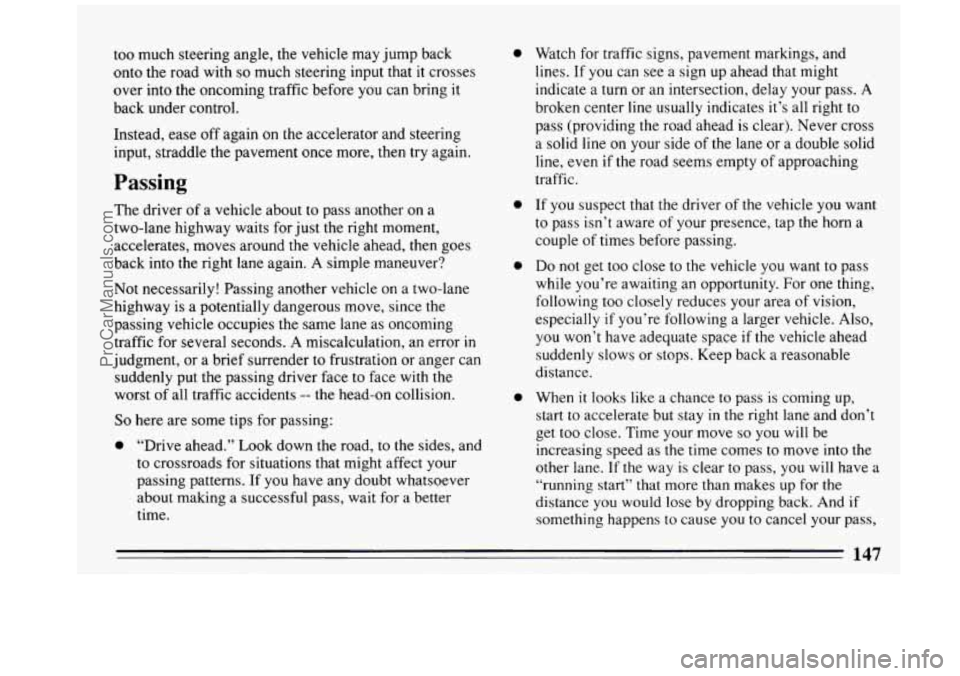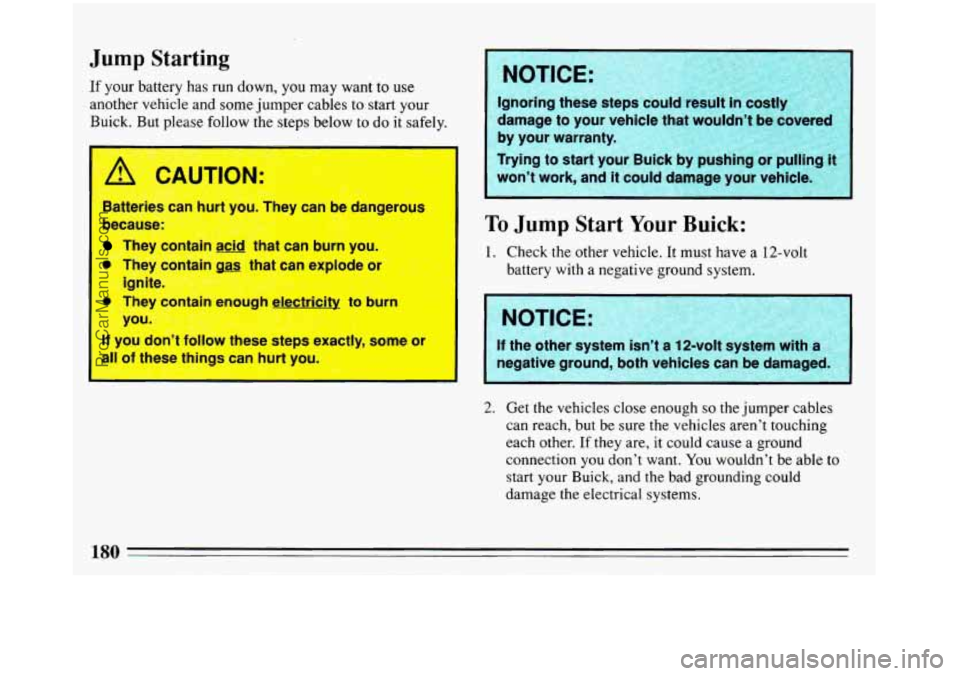1993 BUICK REGAL jump start
[x] Cancel search: jump startPage 149 of 308

too much steering angle, the vehicle may jump back
onto the road with
so much steering input that it crosses
over into the oncoming traffic before you can bring it
back under control.
Instead, ease
off again on the accelerator and steering
input, straddle the pavement once more, then try again.
Passing
The driver of a vehicle about to pass another on a
two-lane highway waits for just the right moment,
accelerates, moves around the vehicle ahead, then goes
back into the right lane again.
A simple maneuver?
Not necessarily! Passing another vehicle on a two-lane
highway
is a potentially dangerous move, since the
passing vehicle occupies the same lane as oncoming
traffic for several seconds. A miscalculation, an error
in
judgment, or a brief surrender to frustration or anger can
suddenly put the passing driver face to face with
the
worst of all traffic accidents -- the head-on collision.
So here are some tips for passing:
0 “Drive ahead.” Look down the road, to the sides, and
to crossroads for situations that might affect your
passing patterns. If you have any doubt whatsoever
about making a successful pass, wait for a better
time.
0 Watch for traffic signs, pavement markings, and
lines. If you can see a sign up ahead that might
indicate
a turn or an intersection, delay your pass. A
broken center line usually indicates it’s all right to
pass (providing the road‘ahead is clear). Never cross
a solid line on your side of the lane or a double solid
line, even
if the road seems empty of approaching
traffic.
0 If you suspect that the driver of the vehicle you want
to pass isn’t aware of your presence, tap the horn a
couple of times before passing.
0 Do not get too close to the vehicle you want to pass
while you’re awaiting an opportunity. For one thing,
following
too closely reduces your area of vision,
especially
if you’re following a larger vehicle. Also,
you won’t have adequate space
if the vehicle ahead
suddenly slows or stops. Keep back a reasonable
distance.
0 When it looks like a chance to pass is coming up,
start to accelerate but stay in
the right lane and don’t
get too close. Time your move
so you will be
increasing speed as the time comes to move into the
other lane.
If the way is clear to pass, you will have a
“running start” that more than makes up for the
distance you would lose by dropping back. And
if
something happens to cause you to cancel your pass,
147
ProCarManuals.com
Page 179 of 308

Part 5 Problems On The Road
Here you’ll find what to do about some problems that can occur on the road .
Part 5 includes:
Hazard Warning Flashers
........................................................
QtherWarningDevices .........................................................
“Jump”Starting ...............................................................
TowingYourBuick ............................................................
Engineoverheating ............................................................
IfaTireGoesFlat .............................................................
ChangingaFlatTire ............................................................
CompactSpareTire ............................................................
If You’re Stuck in Sand, Mud, Ice or Snow ..........................................
...
...
...
...
...
...
...
...
...
178
179
180
185
192
201
201
210
211
ProCarManuals.com
Page 182 of 308

Jump Starting
If your battery has run down, you may want to use
another vehicle and some jumper cables to start your
Buick.
But please follow the steps below to do it safely.
Batteries can Irt u. Thev can be dangerous
because
They ca .An acla that can burn you.
They contain cas that can explode or
ignite.
They collli
arluuyrt electricity +o burn
you.
j. ' , -. ..
I
. ,. ,-.
IT you dc t TC IW ?se steps exactly, some or ' '
,-L*&'.;,:: - $*,. ,t* ...: q all r' "-7se thjnc- . r-an hurt you;ce,, :'-.';".y 'y; ,:'.
To Jump Start Your Buick:
1. Check the other vehicle. It must have a 12-volt
battery with a negative ground system.
If the other system isn't a 12-volt system with a
ground, both vehicles can be damaged.
I
2. Get the vehicles close enough so the jumper cables
can reach, but be sure the vehicles aren't touching
each other. If
they are, it could cause a ground
connection you don't want. You wouldn't be able
to
start your Buick, and the bad grounding could
damage the electrical systems.
ProCarManuals.com
Page 183 of 308

1 CAUTION:
You could be injured if the vehicles roll. Set the
parking brake firmly on each vehicle. Put an
automatic transaxle
in “P” (Park) or a manual
transaxle
in “N” (Neutral).
3. Turn off the ignition on both vehicles. Turn off all
lights that aren’t needed, and radios. This will avoid
sparks and help save both batteries. And it could
save your radio!
4. Open the hoods and locate the batteries.
I
I A CAUTION:
An electric fan can start up even wheVv the engine
is not running and can injure you. Keep hands,
clothing and
tools away from any underhooc‘
electric
fan.
Find the positive (+) and negative (-) terminals on
each battery.
Your Buick has a remote positive (+)jump starting
terminal. The terminal is on the same side
of the
engine compartment as your battery.
You should always use the remote positive (+)
terminal instead of the positive (+) terminal on your
battery.
To uncover the remote positive (+) terminal, lift the
red plastic cap.
181
ProCarManuals.com
Page 237 of 308

balance between your front and rear brakes can change,
for the worse. The braking performance you've come to
expect can change in many other ways
if someone puts
in the wrong replacement brake parts.
Battery
Every new Bukk has a Delco Freedoma battery. You
never have to add water to one of these. When it's time
for a new battery, we recommend a Delco Freedom@
battery. Get one that has the catalog number shown on
the original battery's label.
Vehicle Storage
If you're not going to drive your vehicle for 25 days or
more, take off the black, negative
(-) cable from the
battery. This
will help keep your battery from running
down.
;;? j .-:q -' : i-.; . 6'
Batteries have acid thia'f can &urn you'and gas p. -'
that can explode. You can be badly hurt if you <;*.
aren't careful. See "Jump Starting'' in the Index"
for tips on working around a battery without
Xing hurt.
Contact your dealer to learn how to prepare your vehicle
for longer storage periods.
Halogen Bulbs
A CAUTI IN
Halogen bull have pressurized gas inside and
in burst if you drop or scratch the bulb. You or
orhers could be injured. Take special car vhen
handling
an< "isDoPg of halc-?n hnnlbs
Headlamp Bulb Replacement
d
- 235
ProCarManuals.com
Page 300 of 308

Heater. Engine Block .......................... 70. 224
“Highway Hypnosis”
............................. 160
Hill and Mountain Roads
.......................... 16 1
Hills. Parking on ................................ 163
Hitches. Trailer
.................................. 172
Holding a Baby
in .Your Car ......................... 4 1
Hood. Opening the ............................... 21 8
Horn
........................................... 80
Hot Coolant Warning Gage
........................ 103
Hot Engine. Safety Warnings About
................. 193
Hydroplaning
................................... 153
High
Speed. Shifting When Your Engine is Running at
... 72
Ice. Driving on
................................. 167
Identification Label. Service Parts
................... 256
Identification Number. Vehicle ..................... 256
Idling Your Engine
................................ 78
If You’re Stuck: In Sand. Mud. Ice
or Snow ........... 21 1
Ignition Key Positions ............................. 66
Indicator. Turn Signal ............................. 81
Indicators. Disc Brake Wear
....................... 142
Indicators. Warning Lights and Gages
................ 100
Infant Restraint
................................... 42
Inflation. Tire
................................... 241
Inside Mirror
.................................... 94
Inspection. Tire
................................. 242
Instrument Panel
................................. 99
Interior Cleaning ................................ 248
Introduction. How to Use this Manual
................. 10
..................................... J ack. Tire 202
Jacking Up the Car
............................... 202
“Jump” Starting
................................. 180
Keys
.......................................... 58
Keyless Entry System. Remote
...................... 62
Kilometer Indicator
............................... 99
Label. Service Parts Identification
.................. 256
Lane Change Indicator
............................. 81
LapBelt
........................................ 35
Lap-Shoulder Belt Usage by Children
................. 54
Latches. Front Seatback
............................ 18
Leathercleaning
................................ 250
Leaving Your Vehicle .............................. 77
Light. Safety Belt
................................. 25
Light. Turn Sigllal Indicator
......................... 81
Lighter. Cigarette
................................. 97
Lights Light Bulbs. Replaceable
.......................... 262
Daytime Running
.............................. 92
Fog
......................................... 92
Gages and Warning Indicators
................... 100
“On” Warning ................................ 100
Operation .................................... 91
Reading
...................................... 93
Traffic
...................................... 133
Loading
Your Vehicle ............................ 238
298
ProCarManuals.com